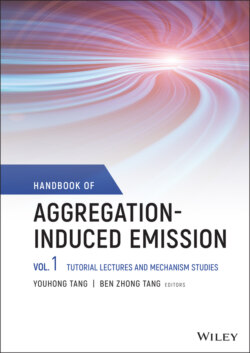Читать книгу Handbook of Aggregation-Induced Emission, Volume 1 - Группа авторов - Страница 37
2.3.4 Flipping Vibrations of Molecular Skeletons
ОглавлениеCyclooctotetraene (COT) is a prototype molecule with nonaromatic annulenes [51–53]. The COT derivative cyclooctatetrathiophene (COTh) was found to be AIE active and its AIE mechanism was further investigated theoretically and experimentally [43]. The theoretically optimized geometries in the S0 and S1 states show that the isolated COTh is much more flexible than that in a cluster. For example, from the S0 to S1 state, the modifications of the dihedral angles ΘI–II and ΘII–III (I, II, and III denote the aromatic rings marked in Figure 2.3) are 22.82° and 24.22° in the gas phase, much larger than those in the solid state of 12.78° and 12.96°. Upon excitation, the dihedral angles between the neighboring thienyl rings are decreased from S0 to S1. As shown in Table 2.3, for example, ΘI–II decreases from 44.93° to 22.11° in the gas phase, while it reduces from 43.84° to 31.06° in the solid phase, indicating a better planarity of the central large eight‐membrane ring. Therefore, the conjugation of the central eight‐membrane improves and the oscillator strength of S1 enhances accordingly. In addition, the excitation energy at the S1 geometry increases from 2.42 eV in the gas phase to 2.69 eV in cluster. Therefore, kr increases from 9.80 × 104 to 6.05 × 105 s−1, owing to the enhancement of oscillator strength and excitation energy; see Table 2.2. The kic is closely related to the reorganization energy. For COTh, the λtotal decreases to 636 meV in crystal from 860 meV in the gas phase and then the kic decreases by 2 orders of magnitude. Thus, the ΦF in the crystal is 3 orders of magnitude larger than that in the isolated state. As shown in Figure 2.4d, the major differences in the reorganization energies between the gas phase and the solid state are related to the low‐frequency eight‐member annulene flipping vibrational mode. Thus, the fluorescence of COTh upon aggregation is induced by the suppression of the nonradiative decay channel contributed by the electron–vibration coupling between the transition electron and low‐frequency flipping vibration (see Figure 2.2e).
Table 2.2 Calculated kr, kic, and ΦF in both solution and aggregate phases at room temperature for TPA, (CAACAd)CuCl, and COTh, respectively.
| k r (s−1) | k ic (s−1) | Φ F (%) | k r (s−1) | k ic (s−1) | Φ F (%) | |
|---|---|---|---|---|---|---|
| In isolated state | In solid phase | |||||
| TPA [41] | 3.34 × 104 | 4.97 × 107 | 0.067 | 3.43 × 107 | 5.15 × 106 | 86.95 |
| (CAACAd)CuCl [42] | 6.26 × 105 | 8.38 × 107 | 0.44 | 7.83 × 105 | 1.47 × 104 | 98.0 |
| COTh [43] | 9.80 × 104 | 4.13 × 109 | 0.002 | 6.05 × 105 | 1.87 × 107 | 3.13 |
